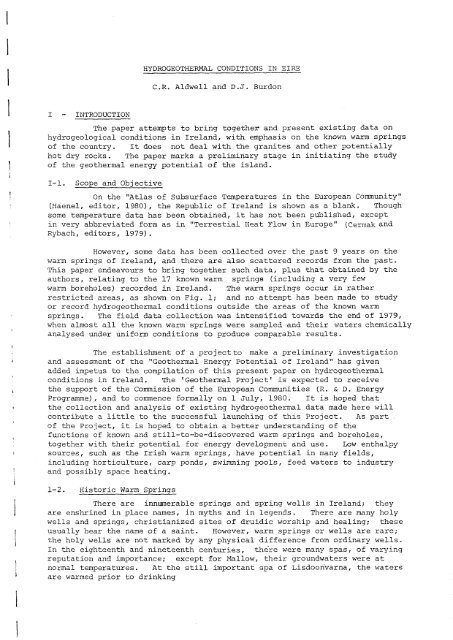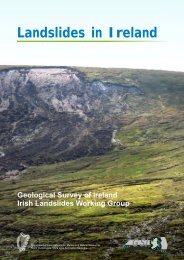Hydrogeothermal Conditions in Ãire - Geological Survey of Ireland
Hydrogeothermal Conditions in Ãire - Geological Survey of Ireland
Hydrogeothermal Conditions in Ãire - Geological Survey of Ireland
You also want an ePaper? Increase the reach of your titles
YUMPU automatically turns print PDFs into web optimized ePapers that Google loves.
HYDROGEOTHERMAL CONDITIONSIN EIREC.R. Aldwell and D.J. BurdonIINTRODUCTIONThe paper attempts to br<strong>in</strong>g together and present exist<strong>in</strong>g data onhydrogeological conditions <strong>in</strong> <strong>Ireland</strong>, with emphasis on the known warm spr<strong>in</strong>gs<strong>of</strong> the country. It does not deal with the granites and other potentiallyhot dry rocks. The paper marks a prelim<strong>in</strong>ary stage <strong>in</strong> <strong>in</strong>itiat<strong>in</strong>g the study<strong>of</strong> the geothermal energy potential <strong>of</strong> the island.I-I.Scope and ObjectiveOn the "Atlas <strong>of</strong> Subsurface Temperatures <strong>in</strong> the European Community"(Haenel, editor, 1980), the Republic <strong>of</strong> <strong>Ireland</strong> is shown as a blank. Thoughsome temperature data has been obta<strong>in</strong>ed, it has not been published, except<strong>in</strong> very abbreviated form as <strong>in</strong> "Terrestial Heat Flow <strong>in</strong> Europe" (Cermak andRybach, editors, 1979).However, some data has been collected over the past 9 years on thewarm spr<strong>in</strong>gs <strong>of</strong> <strong>Ireland</strong>, and there are also scattered records from the past.This paper endeavours to br<strong>in</strong>g together such data, plus that obta<strong>in</strong>ed by theauthors, relat<strong>in</strong>g to the 17 known warm spr<strong>in</strong>gs (<strong>in</strong>clud<strong>in</strong>g a very fewwarm boreholes) recorded <strong>in</strong> <strong>Ireland</strong>. The warm spr<strong>in</strong>gs occur <strong>in</strong> ratherrestricted areas, as shown on Fig. 1; and no attempt has been made to studyor record hydrogeothermal conditions outside the areas <strong>of</strong> the known warmspr<strong>in</strong>gs. The field data collection was <strong>in</strong>tensified towards the end <strong>of</strong> 1979,when almost all the known warm spr<strong>in</strong>gs were sampled and their waters chemicallyanalysed under uniform conditions to produce comparable results.The establishment <strong>of</strong> a projectto make a prelim<strong>in</strong>ary <strong>in</strong>vestigationand assessment <strong>of</strong> the "Geothermal Energy Potential <strong>of</strong> <strong>Ireland</strong>" has givenadded impetus to the compilation <strong>of</strong> this present paper on hydrogeothermalconditions <strong>in</strong> <strong>Ireland</strong>. The 'Geothermal Project' is expected to receivethe support <strong>of</strong> the Commission <strong>of</strong> the European Communities (R. & D. EnergyProgramme), and to commence formally on I July, 1980. It is hoped thatthe collection and analysis <strong>of</strong> exist<strong>in</strong>g hydrogeothermal data made here willcontribute a little to the successful launch<strong>in</strong>g <strong>of</strong> this Project. As part<strong>of</strong> the Project, it is hoped to obta<strong>in</strong> a better understand<strong>in</strong>g <strong>of</strong> thefunctions <strong>of</strong> known and still-to-be-discovered warm spr<strong>in</strong>gs and boreholes,together with their potential for energy development and use. Low enthalpysources, such as the Irish warm spr<strong>in</strong>gs, have potential <strong>in</strong> many fields,<strong>in</strong>clud<strong>in</strong>g horticulture, carp ponds, swL~<strong>in</strong>g pools, feed waters to <strong>in</strong>dustryand possibly space heat<strong>in</strong>g.1-2. Historic Warm Spr<strong>in</strong>gsThere are <strong>in</strong>numerable spr<strong>in</strong>gs and spr<strong>in</strong>g wells <strong>in</strong> <strong>Ireland</strong>; theyare enshr<strong>in</strong>ed <strong>in</strong> place names, <strong>in</strong> myths and <strong>in</strong> legends. There are many holywells and spr<strong>in</strong>gs, christianized sites <strong>of</strong> druidic worship and heal<strong>in</strong>g; theseusually bear the name <strong>of</strong> a sa<strong>in</strong>t. However, warm spr<strong>in</strong>gs or wells are rare;the holy wells are not marked by any physical difference from ord<strong>in</strong>ary wells.In the eighteenth and n<strong>in</strong>eteenth centuries, there were many spas, <strong>of</strong> vary<strong>in</strong>greputation and importance; except for Mallow, their groundwaters were atnormal temperatures. At the still important spa <strong>of</strong> Lisdoorivarna, the watersare warmed prior to dr<strong>in</strong>k<strong>in</strong>g
















